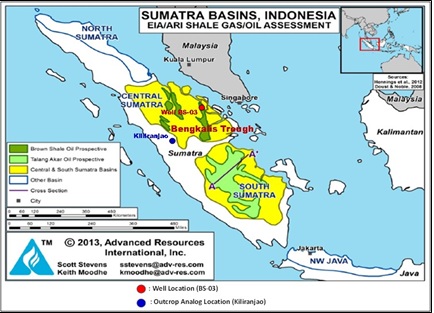Feasibility Study on the Application of Dynamic Elastic Rock Properties from Well Log for Shale Hydrocarbon Development of Brownshale Formation in the Bengkalis Trough, Central Sumatra Basin, Indonesia.
DOI:
https://doi.org/10.25299/jgeet.2021.6.2.5944Keywords:
Elastic Rock Properties, Well Log, Shale Hydrocarbon, Brownshale FormationAbstract
In modeling the hydraulic fracking program for unconventional reservoir shales, information about elasticity rock properties is needed, namely Young's Modulus and Poisson's ratio as the basis for determining the formation depth interval with high brittleness. The elastic rock properties (Young's Modulus and Poisson's ratio) are a geomechanical parameters used to identify rock brittleness using core data (static data) and well log data (dynamic data). A common problem is that the core data is not available as the most reliable data, so well log data is used. The principle of measuring elastic rock properties in the rock mechanics lab is very different from measurements with well logs, where measurements in the lab are in high stresses / strains, low strain rates, and usually drained, while measurements in well logging use the principle of measured downhole by high frequency sonic. vibrations in conditions of very low stresses / strains, High strain rate, and Always undrained. For this reason, it is necessary to convert dynamic to static elastic rock properties (Poisson's ratio and Young's modulus) using empirical equations. The conversion of elastic rock properties (well logs) from dynamic to static using the empirical calculation method shows a significant shift in the value of Young's Modulus and Poisson's ratio, namely a shift from the ductile zone dominance to the dominant brittle zone. The conversion results were validated with the rock mechanical test results from the analog outcrop cores (static) showing that the results were sufficiently correlated based on the distribution range.
Downloads
References
Alfreds R. Jumikis, 1979. Rock Mechanics. Trans Tech Publications.
Alsaif, N.A., Hage, A.R., Hamam, H.H., 2017. Mineralogy and Geomechanical Analysis for Hydraulic Fracturing: An Integrated Approach to Assess Rock Fracability in Sandstone Reservoirs, in: Day 1 Mon, November 13, 2017. SPE.
Basuki, D., 2017. Introduction to GeoPressure Prediction, Workshop of Geomechanics Application in Borehole Stability.
Carnell, 1997. The Syn-Rift Petroleum System of Central Sumatra, in: IPA Pre-Conference Field Trip.
Grieser, W.V., Bray, J.M., 2007. Identification of Production Potential in Unconventional Reservoirs, in: All Days. SPE.
Heidrick, T.L., 2018. A structural and tectonic model of the Coastal Plains Block, Central Sumatra Basin, Indonesia, in: Proc. Indon Petrol. Assoc., 22nd Ann. Conv. Indonesian Petroleum Association (IPA), Jakarta.
J. Katz, B., 1995. Stratigraphic and lateral variations of source rock attributes of the Pematang Formation, Central Sumatra. Bull. Geol. Soc. Malaysia 37, 13–31.
Jin, X., Shah, S.N., Roegiers, J.-C., Zhang, B., 2014. Fracability Evaluation in Shale Reservoirs - An Integrated Petrophysics and Geomechanics Approach, in: All Days. SPE, pp. 153–166.
Longley, I.M., 1990. Pematang lacustrine petroleum source rocks from the Malacca Strait PSC, Central Sumatra, Indonesia, in: Proc. Indon Petrol. Assoc., 19th Ann. Conv. Indonesian Petroleum Association (IPA), Jakarta.
Luo, X., Were, P., Liu, J., Hou, Z., 2015. Estimation of Biot’s effective stress coefficient from well logs. Environ. Earth Sci. 73, 7019–7028.
Sunardi, E., 2015. The Lithofacies Association of Brown Shales In Kiliran Jao Subbasin, West Sumatra Indonesia. Indones. J. Geosci. 2, 77–90.
US Energy Information Administration (EIA), 2015. Technically Recoverable Shale Oil and Gas Resources in Indonesia.

Downloads
Published
Issue
Section
License
Copyright @2019. This is an open-access article distributed under the terms of the Creative Commons Attribution-ShareAlike 4.0 International License which permits unrestricted use, distribution, and reproduction in any medium. Copyrights of all materials published in JGEET are freely available without charge to users or / institution. Users are allowed to read, download, copy, distribute, search, or link to full-text articles in this journal without asking by giving appropriate credit, provide a link to the license, and indicate if changes were made. All of the remix, transform, or build upon the material must distribute the contributions under the same license as the original.










